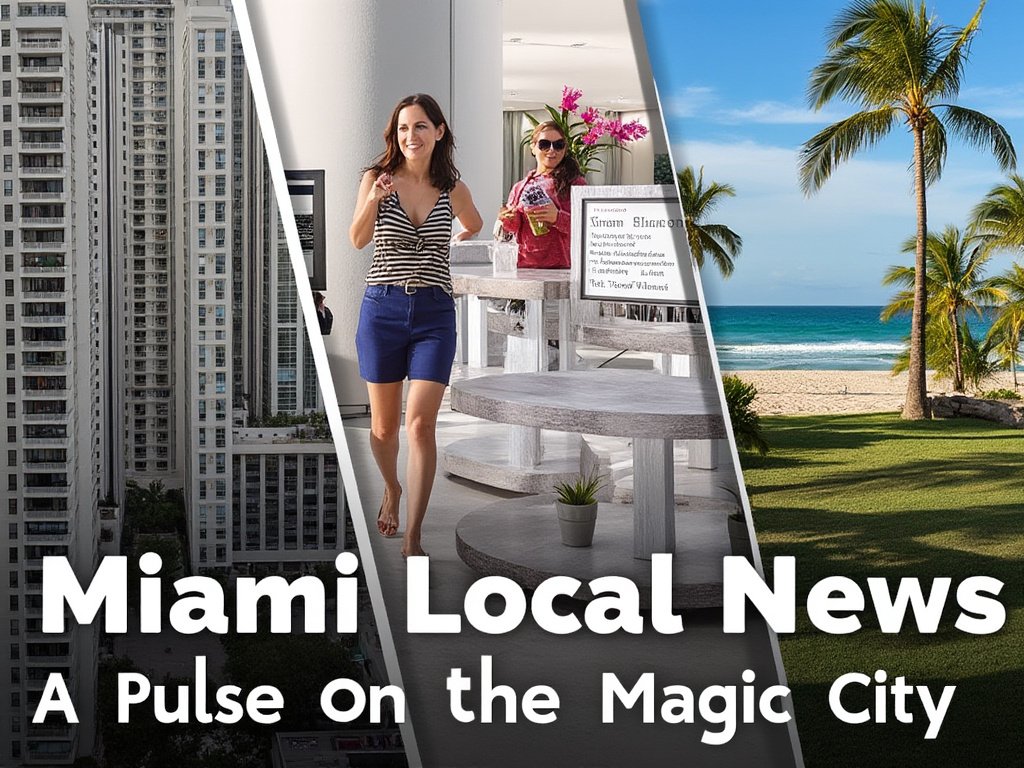Miami, often referred to as the “Magic City,” is known for its eclectic blend of cultures, stunning waterfronts, and a thriving community that keeps the city buzzing with life. But beneath the glamour of its beaches and nightlife, Miami has a complex and vibrant local scene that affects millions of residents on a daily basis. From political shifts and infrastructure development to local business innovations and environmental challenges, Miami’s local news is as diverse and fast-paced as the city itself.
This article offers a dive into some of the most pressing stories shaping Miami right now. Let’s take a closer look at the heartbeat of Miami’s current events—from politics and business to social issues and community highlights.
1. Politics and Governance: Steering the Ship of a Growing City
Miami’s Mayoral Landscape
The political landscape of Miami has always been dynamic, and with recent elections, it’s become even more so. Miami’s mayoral elections draw significant attention not only for their impact on local governance but also because of Miami’s unique position on the national stage. The city, which serves as a cultural and economic bridge between the United States and Latin America, often finds itself at the crossroads of international relations, trade policies, and immigration debates.
The latest election cycle has seen several candidates vying to address critical issues like affordable housing, transportation, and the ever-growing concerns over climate change and rising sea levels. While the current administration has made strides in infrastructure and economic development, critics argue that more needs to be done to address the housing crisis that is pricing out many long-term Miami residents.
As the race for mayor continues to intensify, residents are looking closely at policies that will shape the future of this fast-growing city. The spotlight is on creating sustainable urban growth while balancing the needs of a multicultural population.
County Governance and Regional Cooperation
In Miami-Dade County, the board of commissioners plays a pivotal role in managing the region’s day-to-day affairs. From budget allocations to public health policies, the commissioners are tasked with ensuring that the city’s diverse population is represented and cared for. Recent discussions have centered around public transportation improvements, with Miami residents growing increasingly frustrated with congestion and long commute times.
Efforts are underway to expand the Metrorail system and increase the efficiency of public bus services, but funding and execution remain challenges. As Miami continues to grow, both city and county officials will need to collaborate more effectively to address these pressing issues.
2. Business and Economy: The Booming Tech Hub and Real Estate Market
Miami’s Tech Boom
Over the past few years, Miami has positioned itself as a burgeoning tech hub. Spearheaded by a favorable tax climate and the allure of a tropical lifestyle, many Silicon Valley companies and entrepreneurs have set up shop in the city. From start-ups to established giants, tech companies are betting on Miami as the next big thing. Mayor Francis Suarez has been a vocal advocate for transforming Miami into a “crypto-friendly” city, pushing for innovations like Bitcoin payments for city services.
However, the rapid influx of tech money and talent has also sparked concerns among local communities. With higher-than-average wages being offered in the tech sector, the cost of living has surged, leading to an increasingly polarized economic landscape. While tech executives enjoy luxury waterfront homes, many long-term residents are being displaced due to rising rents.
The challenge for city officials moving forward will be to create a balanced economy—one that fosters innovation but also protects the city’s most vulnerable residents. At the moment, Miami’s tech boom seems unstoppable, but its ripple effects are being felt throughout the community.
Real Estate Market: A Double-Edged Sword
For decades, Miami’s real estate market has been synonymous with luxury condos, towering skyscrapers, and oceanfront properties. Even during economic downturns, the city’s real estate sector has shown remarkable resilience. Today, Miami’s housing market continues to thrive, but it’s also facing significant issues related to affordability and availability.
In the wake of the pandemic, Miami became one of the hottest real estate markets in the country. High-net-worth individuals from across the United States flocked to South Florida, snapping up multi-million-dollar homes and driving up property values. While this has been a boon for developers and real estate investors, it has created a housing crisis for many middle and low-income residents.
There is a growing demand for affordable housing projects, but zoning laws and regulatory hurdles have slowed progress. This issue has become a central topic of debate in local politics, with advocacy groups pushing for more inclusive housing policies that will allow Miami residents to live and work in the city without being priced out.
3. Environmental Challenges: Miami at the Frontlines of Climate Change
Rising Sea Levels and Flooding Concerns
Miami is often described as ground zero for climate change in the United States. With its low-lying coastal geography, the city is highly vulnerable to rising sea levels and the increased frequency of extreme weather events. Over the last decade, “king tides” have become a regular occurrence, flooding neighborhoods and damaging infrastructure, even on sunny days.
Local officials have begun implementing long-term strategies to combat these challenges. Miami’s climate action plan focuses on reinforcing infrastructure, creating more green spaces, and investing in water management systems. However, the clock is ticking. Scientists predict that Miami could see a significant portion of its urban landscape underwater by 2050 if global temperatures continue to rise at the current rate.
Residents, particularly those living in coastal areas like Miami Beach, are already feeling the impacts of these environmental changes. Increased flooding has led to higher insurance premiums, and in some cases, has made certain areas uninhabitable. The question facing Miami now is whether these efforts will be enough to protect the city in the coming decades.
The Push for Sustainability
On the positive side, Miami has embraced sustainability efforts across various sectors. From electric buses to eco-friendly building initiatives, the city is making strides in reducing its carbon footprint. Miami-Dade County has launched several green initiatives, including urban farming projects, solar energy expansions, and increased investment in sustainable public transportation.
The community is also stepping up. Local environmental groups have been vocal in advocating for greater government accountability and pushing for faster implementation of eco-friendly policies. In a city as diverse as Miami, the path to sustainability requires a multifaceted approach that includes businesses, residents, and policymakers working together to mitigate the effects of climate change while fostering a more resilient economy.
4. Arts and Culture: A Melting Pot of Creativity
Wynwood’s Evolution
Miami’s cultural scene is a vibrant reflection of its diverse population. From the high-end galleries of the Design District to the street art-covered walls of Wynwood, Miami’s arts community continues to thrive and evolve. The Wynwood Arts District, once an industrial neighborhood, has transformed into one of the city’s most dynamic cultural hubs. It’s home to world-renowned galleries, innovative art installations, and some of the most celebrated street art in the world.
Wynwood’s growth has mirrored the larger cultural renaissance taking place in Miami. The annual Art Basel event brings together the who’s who of the global art world, turning the city into a playground for collectors, artists, and curators. Local galleries have flourished, and new museums like the Pérez Art Museum Miami (PAMM) have become central to the city’s artistic identity.
However, this growth has not come without controversy. The rising popularity of Wynwood has led to a rapid gentrification of the area, with many long-term residents and small businesses being displaced. Balancing the influx of new investment with the need to preserve the cultural heritage of Miami’s neighborhoods remains a key issue.
Latin Music and Entertainment
Miami is also a powerhouse when it comes to music and entertainment, especially Latin music. The city has long been the gateway for Latin American artists breaking into the U.S. market, and its influence can be seen across the entertainment industry. Stars like Shakira, Gloria Estefan, and Pitbull call Miami home, and the city continues to serve as a launchpad for new talent.
From reggaeton to salsa, Miami’s music scene is one of the most eclectic in the world, and its influence extends far beyond its borders. With an endless array of concerts, festivals, and nightlife options, Miami continues to be the epicenter of Latin music and a hub for artists looking to make it big.
5. Social Issues: A City of Contrasts
Affordable Housing Crisis
Miami’s affordability crisis remains one of the most significant social issues facing the city today. Despite its booming economy, Miami consistently ranks as one of the least affordable cities in the United States. This affordability gap has widened due to the influx of new residents, particularly from New York and California, who have driven up property prices.
Efforts to address the housing crisis include the development of affordable housing units and rent control measures, but progress has been slow. Advocacy groups are calling for more drastic reforms, including increased government intervention and stricter regulations on new developments.
Immigration and Community Tensions
As a gateway to Latin America, Miami has always had a close relationship with immigration. The city is home to large communities of Cubans, Venezuelans, Colombians, and Haitians, among others. While this diversity has enriched the city culturally, it has also led to unique challenges, particularly concerning immigration policy and community integration.
Miami continues to be a flashpoint for national immigration debates, especially concerning asylum seekers and undocumented immigrants. The city’s immigrant communities have expressed concerns over increased deportation efforts, while local advocacy groups continue to fight for the rights of those seeking a better life in the U.S.
Conclusion: Miami’s Future—Challenges and Opportunities
Miami is a city in constant motion. It’s a place where cultures collide, industries thrive, and challenges loom large. From navigating its political landscape to addressing climate change and economic inequality, Miami’s future is being shaped by the events unfolding today.
What makes Miami unique is its resilience and its ability to evolve. Whether through its booming tech industry, its commitment to the arts, or its fight against rising sea levels, Miami has proven that it is a city capable of meeting its challenges head-on. And while the road ahead may be filled with obstacles, the Magic City is determined to carve out a future that is as bright and dynamic as its skyline.





